Quantitative, real-time, sub-cellular tracking of HIV-1 viral particles

Cryo-electron tomography reconstitution of HIV-1 viral particles (Briggs et al., Structure, 2006)
After HIV-1 fuses with a target cell membrane, the virion core is delivered into the cytosol of the infected cell. A DNA copy (cDNA) of the HIV-1 RNA genome is produced by the HIV-1 reverse transcriptase (RT) and the cDNA is ligated to host cell chromosomal DNA by HIV-1 integrase. Despite 30 years of research, a detailed understanding of these essential early steps in HIV-1 replication remains elusive.
Up to this point, progress has been impeded by the fragile nature of HIV-1 replication intermediates and the low infectivity-to-particle ratio of virions, which makes it difficult if not impossible to meaningfully dissect different steps in the pathway by bulk biochemical means alone.
The goal of this project is to remedy this lack of understanding by developing methods to label and track infectious HIV-1 as it traverses living cells in real-time. The aim is to identify rare particles that successfully integrate into chromosomal DNA, map their intracellular path as they travel to reach the cellular genome and identify their intracellular interaction partners, in time and space-resolved manner. Such information will be invaluable for furthering our understanding of the initial steps in the HIV-1 life cycle and for the rational design of anti-HIV-1 drugs that target them.
Address key open questions in HIV-1 virology using OMEGA
Using dynamic imaging followed by rigorous computational analysis of viral particle trajectories, the complex interplay between HIV-1 and cellular components can be solved. A major hurdle has been the difficulty of keeping track of multiple moving viral particles with sufficient temporal and spatial resolution while at the same time probing multiple experimental contexts.
We expect that the OMEGA project will give a major contribution to addressing this gap by developing integrated workflows that will provide the analysis, data management and visualization capabilities required to drive a more complete understanding of viral-host interactions in the context of living human tissues.